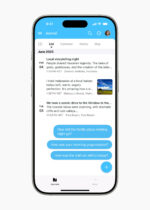One billion dollars. That’s how much money Apple CEO Steve Jobs said the company has paid to iPhone application developers for their 70% share on the more than 5 billions applications downloaded by users thus far.
In his keynote address at Apple’s Worldwide Developers Conference that began today in San Francisco, Jobs also highlighted some other App Store numbers, saying that 15,000 apps are submitted each week to the store, which now has more than 225,000 applications. Most apps are approved for sale within seven days, he said.
Jobs also used his address to announce a new version of the iPhone, called iPhone 4. It includes many upgrades to the hardware and the operating system, including the iPhone OS 4.0, renamed iOS 4, which allows multitasking and the use of multiple applications at once. He said iOS 4 is currently in the “golden master candidate” phase of production, which means it is ready for manufacturing.
As if in response to the features Google promised for its Android platform at its own developers conference in May, Jobs announced a new network for selling advertising within iPhone applications. Named iAds, the new service sounds similar to Google’s AdWords, yet will focus exclusively on iOS-based devices. Developers will pull ads from Apple’s ad service and will receive 60% of revenues generated by ad sales in their applications. Jobs claimed to have brought over 48% of the entire U.S. mobile advertising market to use iAds already.
This offering is similar to that announced by Google last month. Then, Google showed off in-app advertising services that allow developers to embed rich content into their ads, and to leave the applications in which they are embedded running during advertising-related activities.
In an ironic twist, Jobs’ keynote was marred by wireless difficulties, which prompted him to ask the audience to turn off all WiFi devices so as not to interfere with the on-stage demonstration.
Jobs closed out the iPhone 4 announcement with a demonstration of video chat using the device. To demonstrate the new feature, he called Jony Ive, the famous industrial designer at Apple who created the iMac and the iPod. This was the same way Jobs introduced the iPhone in 2007, with a live, on-stage call to Ive.
“The idea of communicating this way is an old idea, but we’ve had to wait an awfully long time for it to become reality,” said Ive during the call. Jobs then intimated that the video chatting features of the iPhone only work over WiFi and not over the cellular network, though Jobs said he hoped to add cellular support next year. The service will also only work on iPhone 4-to-iPhone 4 calls.
The Apple iPhone 4 goes on sale on June 24. By the end of September, Jobs said Apple hopes to be shipping iPhones to 88 different countries.






